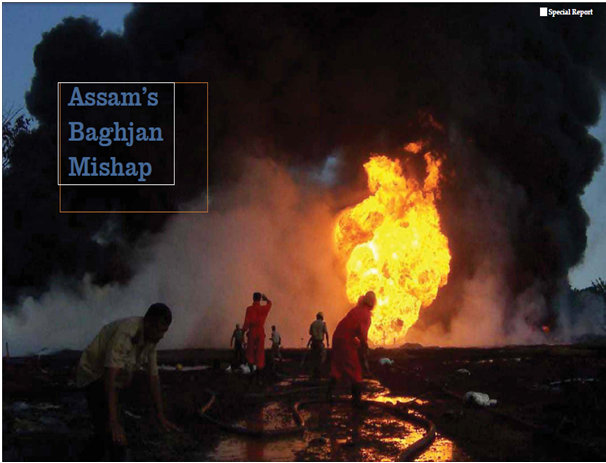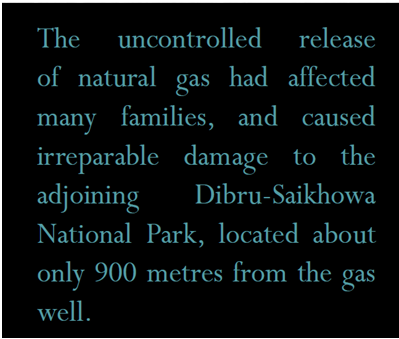
The blowout incident at the Baghjan oilfield of the Oil India Limited (LTD) is saddening. This can well be considered as one of the worst industrial disasters which the country has witnessed in the recent times. In other words, this is the second such major leaking incident since 2005 – let alone several other similar incidents of oil and gas spill in the recent past. Notably, the Baghjan gas leak happening is literally a two-part story, but, depressingly, both incidents have been a bitter pill to swallow for the people, especially those who live in villages within two kms radius of the uncontrollable gas outflow site. To argue precisely, both the incidents have almost irreversibly damaged lots of still-existing precious resources --cropland, water-bodies, a national park et al in its vicinity but have also taken heavy toll on the villagers’ livelihoods.
It needs mention here that the spark for the brewing crisis at the Baghjan gas and oil well in Tinsukia district was the sudden major up-rush occurring there on May 27. Since then, natural gas has been uncontrollably spewing from a rig of the Oil India Limited at the site triggering fear and panic amongst the local inhabitants. The gas leak continued unabated for a little less than a fortnight before till the well finally caught fire on June 9. But it is unfortunate that during the prolonged period the unbridled release of natural gas could not be put at check maybe because the country’s petroleum industry lacks such an expertise to cap the well head notwithstanding its having over a hundred years of history of oil exploration, or because of the alleged failure of a private drilling firm which was reportedly engaged in exploration but did not have a much-needed quick disaster management and mitigation mechanism in place to face up to any emergency situation. A recent report suggested that the same company was even advised by a technical team of the OIL after totally cementing a new sand reservoir from which gas was to be produced on May 26, a day before the oil well went into flames, not to work on the cemented structure before 48 hours. But the company instead, allegedly started working on that structure on May 27 to expedite the job, leading to the gas-leak.
The crisis reveals that the OIL was reportedly undertaking workout operations at Baghjan on May 27 when around 10.30 am, the blowout took place in its gas well resulting in the flow of gas. The well started spewing gas uncontrollably since then. A conscious segment of the Baghjan population was of the opinion that the disaster had happened due to the alleged procrastination in the routine check and maintenance of the gas rig by the officials and staff of the out-sourcing firm, John Energy Pvt. Limited. The group was confident that had they at the very beginning put in serious efforts to cap the well, it could have possibly been avoided. Their allegations against them were genuine and well manifested in the suspension of dereliction of duty as also in the issuance of show-cause notice against the drilling company.
If the available media reports are anything to go by, one can say for certain that the first major blowout at Baghjan of May 27 was much too devastating. The uncontrolled release of natural gas had affected many families, and caused irreparable damage to the adjoining Dibru-Saikhowa National Park, located about only 900 metres from the gas well. Cropland, water-bodies and the Motabung Beel, about 200 metres from the site, being a prime wetland and an Important Bird Area (IBA), had also been severely impacted by the condensate blowout given a black, petrol-like substance and gas spilling across the water-bodies leading to the deaths of fish, birds and many animals including dolphin, the carcasses of which have been recovered.
In the emerging worst-case scenario, putting in place a quick response workable mechanism against such accidents was the call of an hour because the OIL came a cropper even after a week of the gas leakage to balance the situation. However, finally on June 4, a three-member team of Singapore-based disaster control experts reached the Baghjan blowout site. The experts from Singapore-based M/S Alert Disaster Control tried utmost but were unable to bring the Baghjan gas blowout under control even after 4/5 days of their arrival.
workable mechanism against such accidents was the call of an hour because the OIL came a cropper even after a week of the gas leakage to balance the situation. However, finally on June 4, a three-member team of Singapore-based disaster control experts reached the Baghjan blowout site. The experts from Singapore-based M/S Alert Disaster Control tried utmost but were unable to bring the Baghjan gas blowout under control even after 4/5 days of their arrival.
The situation there, however, suddenly took a turn for the worse on June 9, when the leaking gas well caught fire in the afternoon, triggering chaos and panic in the surrounding villages and few tea gardens nearby. Tea pluckers in the Dighulturrung estate reportedly fled from a garden which was barely one and a half kilometres from the oil well. The blaze was so massive that it could be sighted from a distance of more than 30 kms with thick black smoke rising several metres, badly impacting local bio-diversity in Dibru-Saikhowa National Park. Some eyewitnesses said, that the rising blaze even could be seen even from Doomdooma. It may be noted here, that hundreds of people amidst hissing sound emanating from the fire of the Baghjan oilfield, there was a series of low-to-moderate intensity tremors at Nutangaon in Tinsukia district which terrorized them. Hundreds of people were hurriedly shifted to the Guijan High school following continual tremors for few days in a row at the interval of every 15-20 minutes resulting in cracks in several nearby houses. An OIL official said it was not from underground sources but triggered over ground.
As condensate spilled over to the adjoining areas, the towering inferno also swept through a vast area of the wetland and the national park around the gas well damaging as many 50 houses, bamboo plants and other agricultural fields. Meanwhile, the company and the Tinsukia District Administration have reportedly moved around 7,000 people from nearby areas of the gas well site to 12 relief camps. Earlier, some people who were housed in relief camps in Baghjan areas have been shifted to several schools including Bandarkhati H S School, Bandarkhati Nagamati L.P School. On that fateful day, the fire killed OIL’s two fire-fighters, Durlov Gogoi, 35 and Tikheswar Gohain 55. Their bodies were brought out from a pond on June 10 which they had probably jumped into to escape the blaze. The cause of the fire is still unknown. It is assumed that the cleaning operations at the accident site might have ignited the fire. One thing is clear that unless the leak and fire are brought under control, more damages cannot be ruled out. What disappointing is that with the blow out and subsequent fire, a large number of local people are deprived of their livelihood from eco-tourism such as running eco-resorts and other related activities, selling tea, agricultural products etc.
Dwaipayan Dasgupta
To read the further articles please get your copy of Eastern Panorama July issue @http://www.magzter.com/IN/Hill-Publications/Eastern-Panorama/News/ or mail to contact @easternpanorama.in


